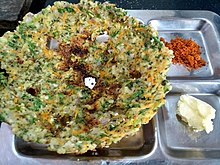 Akki rotti with chutney powder and butter | |
| Place of origin | India |
|---|---|
| Region or state | Karnataka |
| Serving temperature | Hot |
| Main ingredients | Rice flour, water |
Akki rotti or akki roti is an Indian flatbread made from rice flour. It is a part of Karnataka cuisine.[1][2]
Versions[edit]
Akki roti has at least two versions. The most common version is similar to the Maharashtrian flatbread thalipeeth. In this version, rice flour is mixed with onions or grated carrots and green chillies. The resulting dough is flattened on a tava (griddle) or banana leaf and roasted on a stovetop. The cooked akki roti is served with unsalted butter, chutney, or pickle. In contrast with thalipeeth, akki roti has a chewy texture.[1][2][3]
The second version is from Kodagu (a district in southern Karnataka) and is similar to the Indian flatbread bhakri. In this version, cooked rice, rice flour and salt are mixed, resulting in a soft dough. The dough is flattened and cooked on a tava. It is then roasted on an open flame, which chars its edges. The cooked Kodagu akki roti is served with butter or ghee and curry.[1][3][4]
Akki roti is also similar to the Malabar rice flour pancake pathiri.[2]
See also[edit]
- Cuisine of Karnataka
- Thalipeeth
- Bhakri
- Pathiri
- Ragi rotti
- Jolada rotti
- Kori rotti
- List of Indian breads
- List of rice dishes
References[edit]
- ^ a b c Saee Koranne-Khandekar (2016). Crumbs! Bread Stories and Recipes for the Indian Kitchen. Hachette India. p. 22.
- ^ a b c Arathi Kannan (2011). From the South: Delectable Home Cooking. DC Books Limited. p. 50.
- ^ a b Saee Koranne-Khandekar (2016). Crumbs! Bread Stories and Recipes for the Indian Kitchen. Hachette India. p. 220.
- ^ Charmaine O'Brien (2013). The Penguin Food Guide to India. Penguin Books Limited. p. 378.
Well, that’s interesting to know that Psilotum nudum are known as whisk ferns. Psilotum nudum is the commoner species of the two. While the P. flaccidum is a rare species and is found in the tropical islands. Both the species are usually epiphytic in habit and grow upon tree ferns. These species may also be terrestrial and grow in humus or in the crevices of the rocks.
View the detailed Guide of Psilotum nudum: Detailed Study Of Psilotum Nudum (Whisk Fern), Classification, Anatomy, Reproduction